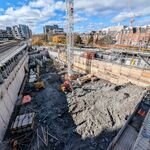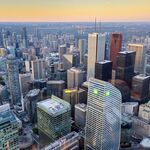salsa
Senior Member
That is precisely why the Bramalea stop on the Steeles Zum route is where it is.....if it were closer to Bramalea road people would be on here noting how stupid it is to have a higher order bus route stop so far from a regional bus/rail depot like the Bramalea GO station.
If that's the case, then Brampton could have found a better way to do it.
1. First of all, why is this northbound bus stop (on Bramalea Rd) so far away from Steeles?

2. If the goal was to offer an easy connection to GO, then why not create a bus loop in the station itself as was done on Bramalea Rd?
3. Or alternatively, why not move the Zum stop much closer to it, and add a second stop just east of Bramalea? In fact, given that most Brampton intersections are about at pedestrian friendly as a freeway offramp, I think there should be east side and west side stops everywhere before somebody gets killed trying to cross the road.

4. How come the westbound Zum stop is right at the intersection where it's supposed to be, but somehow it's the job of the eastbound stop to be closer to GO?

Sorry, but this is just awful. It doesn't offer an easy transfer from Zum to five other bus routes, nor does provide an elegant connection to GO if that's really what they tried to do. Their attempt to do two things at once resulted in a half ass situation that doesn't help anyone.
There are many things we do wrong in Brampton but I think the city does as good a job as any suburban city (better than a lot) in its transit system growth/development....yes there is a long way to go (and they seem to be willing to go that long way) but when I use BT I don't feel all that inconvenienced.
Sadly, that is true. Service levels today are as good as they can be for a city like Brampton. I guess I've been spoiled by the TTC, because on that same day when I used Brampton transit to pick up my package at Fedex, I bussed all over Scarborough, North York, and Etobicoke to take pictures of dozens of condo construction sites. I made well over 20 bus and subway rides, and still had plenty of daylight left. This is how much ground I covered in the span of only six hours, on a holiday schedule in late December. Then when it got dark, it was time to go Mississauga via Brampton Transit, from Humber College to Derry Rd & Bramalea. It was a simple trip requiring only two buses each way, and it wasn't even a long distance trip. However my presto records show that I nearly missed the two hour time transfer by the time I tapped on the fourth bus, so it probably took about 2.5 hours in total to make the full circle back to Humber College, just to go to and from one destination. But I guess I should be thankful that it's not like Baton Rouge, Louisiana.
As for the Boylen Road stop.....seems a bit harsh to be calling out Brampton Transit on the state of a stop serving a primarily industrial area of another city....no?
No. They don't seem to care much about their own city either.



Last edited:







